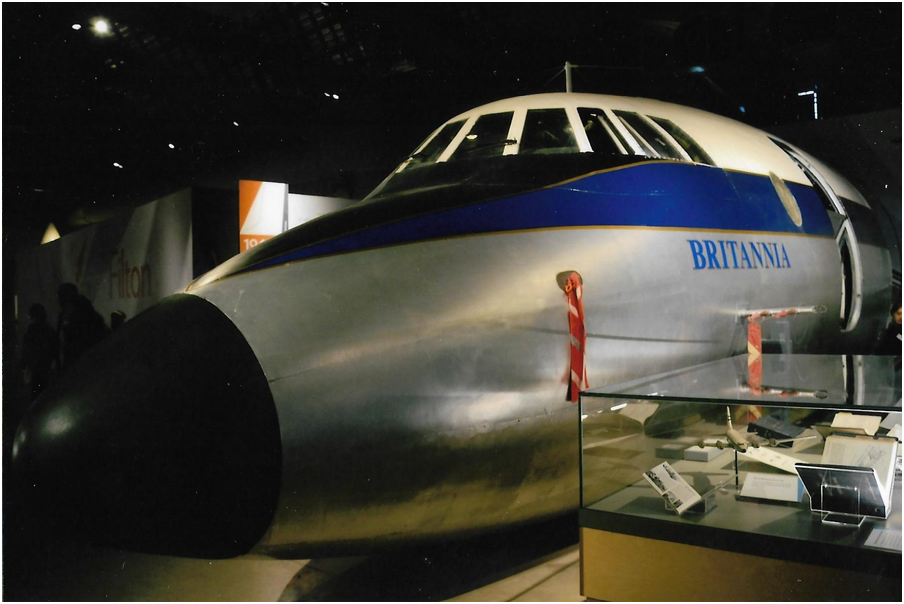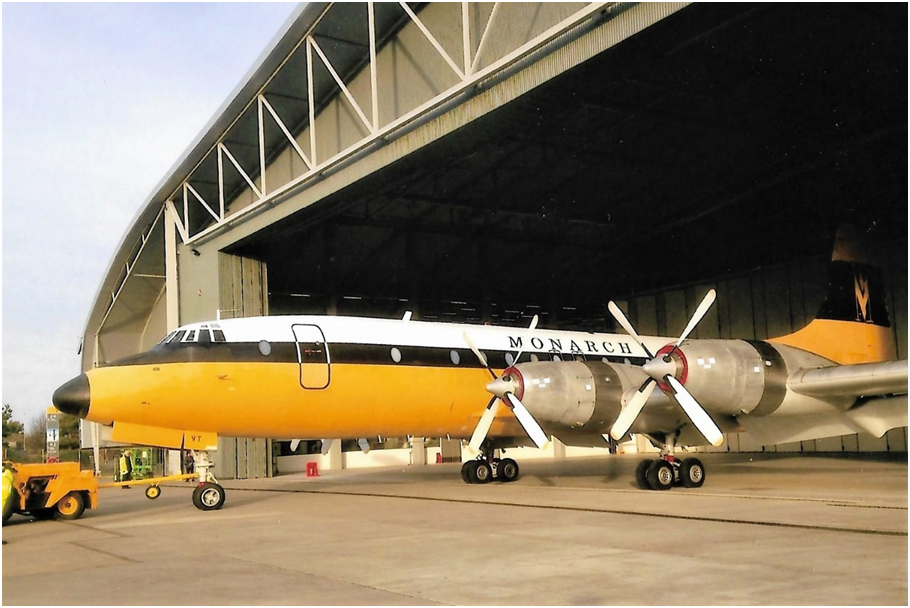


In a year full of anniversaries, Keith Bradshaw highlights the 60th anniversary of the delivery of our Brit to BOAC
And rule the Atlantic she did. The Britannia and its CL44 derivative were the only turbo prop aircraft to operate regular passenger flights across the North Atlantic between 1957 and 1964. Only the Britannia made the journey non-stop. The Icelandic airline Loftleidir CL44s interrupted their flights for a brief halt in Iceland as part of their low-cost fare structure.
60 years ago on 1 January 1959, just two weeks after her maiden flight, Britannia 312 G-AOVT made the short journey from its birthplace at Filton near Bristol to London Airport for delivery to BOAC as part of their 33-strong Britannia fleet. Being a ‘300’ series made OVT a long-range, slightly larger version than the earlier ‘100’ series Britannias BOAC were already operating.

Known as the ‘Whispering Giant’, the prototype Britannia first took to the air seven years earlier in July 1952 with a second aircraft following in December 1953. However, just a couple of months later this aeroplane was being demonstrated to KLM in the hope of selling them some Britannias when shortly after take off from Filton the number three engine had to be shut down due to high oil temperature. The problem did not resolve itself as a propeller gear wheel had stripped its teeth. This allowed the low pressure turbine to spool up to very high speed and eventually destroy itself. Parts from this ruptured the oil tank causing the engine to catch fire.
The fire could not be contained and pilot Bill Pegg attempted to return to Filton but due to the intensity of the fire elected to make a forced landing on the river Severn mud flats. This he achieved successfully and the 13 passengers and crew all escaped with only minor injury. The mud also had the effect of dousing the fire. Efforts were made to recover the aircraft but this could not be done before the tide came in. Salt water damaged the almost new aeroplane which had to be scrapped. Only the cockpit section survived and is now on display at the Bristol Aerospace museum.
KLM never did buy Britannias !

Back to our Brit ‘OVT. As the last of the 312 series to be delivered, she was soon put to work on BOAC’s expanding North Atlantic routes, sharing the service with the new Comet jet airliners. The Britannia’s scheduled time for the crossing from London to New York was 12 hours. However they often beat this with a fastest time of nine and a half hours being achieved in 1958. By 1961 the Britannia fleet operated its last full year with BOAC and by the end of the year the shorter range Britannia 102s were being offered for sale. During 1961 ‘OVT spent a few months flying short-haul routes for BEA when they leased her from BOAC to fill a shortfall in Vanguard capacity.
By November 1962 all the 102 versions had been either sold or withdrawn and placed in storage awaiting sale. The long-range 312 fleet would continue until the final service, a Bermuda to New York leg, was operated in April 1965. By then the VC10s had arrived and taken over many of the old Britannia routes. ‘OVT, despite being the last Britannia 312 to be delivered to BOAC was in fact the first to depart when in September 1963 she was sold to British Eagle to begin a new chapter in her career.

On 3 November 1963 ‘OVT opened the Heathrow-Glasgow route on behalf of British Eagle. This was the first time any independent British airline had been allowed to compete directly with the state owned BEA on the route. The following day she repeated this exercise on the Heathrow to Edinburgh route. Keen to offer a high level of service on these routes Eagle’s sales brochures stated ‘no plastic glasses or cutlery will be used to accompany the full meal service during the flight’ On New Year’s day in 1964 ‘OVT opened another new route - this time London to Liverpool. For a few more years she was once again crossing the Atlantic on charter flights. However all was not well at British Eagle and on 6 November 1968 all flying ceased ‘OVT’s time with them had already come to an end when she was sold to Monarch in August of that year.

Resplendent in her bright yellow colour scheme ‘OVT joined the Monarch fleet which by the summer of 1969 stood at six Britannias. These were used on many inclusive tour flights, Ministry of Defence and charter flights again making the odd trip across the Atlantic to the US or Canada. By the early seventies Monarch had started introducing Boeing 720 jets and the Britannia fleet was slowly wound down until by 1974 ‘OVT was the sole passenger-configured Brit left in Monarch service. It operated the last European passenger flight by a Britannia in October 1974 when it returned to Luton from Lisbon on behalf of Northeast airlines, its last Monarch passenger flight having taken place four days earlier on the 9 October. Her cabin was then stripped of all the seats and galleys and she was placed on lease as a freighter with Invicta Airlines until March 1975. After her return to Monarch at Luton she was offered to the Duxford Aviation Society for preservation arriving at Duxford on 29 June 1975.


After many years hard work sourcing and refitting the cabin ‘OVT looks like it did when it was in passenger service. All this work has been done by the society’s volunteers some of whom are ex- Monarch staff. Despite constant care and attention, by 2017 the paintwork was looking very worn and jaded and no amount of cleaning and polishing could restore it, so the decision was taken to go for a repaint. Out in the open, the fuselage was scaffolded up and volunteers took two weeks to sand and repaint the white on the cabin roof.

Once this was complete there was a short break before in early 2018 she was towed into the AirSpace hangar to complete the painting. In just two weeks the volunteers turned out a remarkable job and she was towed back to her parking spot looking like new.



Work has continued with all the cabin windows replaced during the last 12 months and now the engines and cowlings are being cleaned, painted and polished.


All this attention will hopefully see her good for many years to come so visitors can come and see the Britannia, the aircraft that once ruled the Atlantic. But she will be most likely best remembered for her early ‘70s inclusive tour work with Monarch

‘till the next time Keith
Registered Charity No. 285809